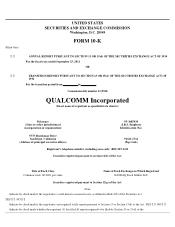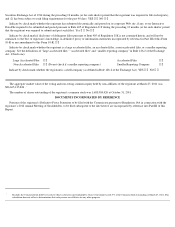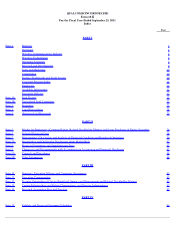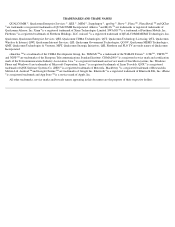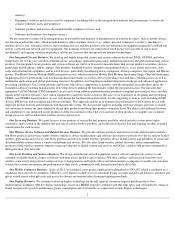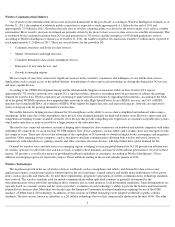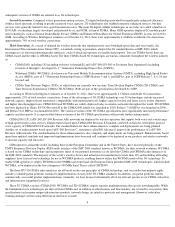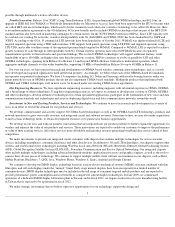Qualcomm 2011 Annual Report Download - page 6
Download and view the complete annual report
Please find page 6 of the 2011 Qualcomm annual report below. You can navigate through the pages in the report by either clicking on the pages listed below, or by using the keyword search tool below to find specific information within the annual report.
In this document, the words “Qualcomm,” “we,” “our,” “ours” and “us”
refer only to QUALCOMM Incorporated and its subsidiaries and not
any other person or entity.
PART I
Item 1. Business
This Annual Report (including, but not limited to, the following section regarding Management’s Discussion and Analysis of Financial
Condition and Results of Operations) contains forward-looking statements regarding our business, financial condition, results of operations and
prospects. Words such as “expects,” “anticipates,” “intends,” “plans,” “believes,” “seeks,” “estimates” and similar expressions or variations of
such words are intended to identify forward-looking statements, but are not the exclusive means of identifying forward-
looking statements in this
Annual Report. Additionally, statements concerning future matters such as the development of new products, enhancements or technologies,
sales levels, expense levels and other statements regarding matters that are not historical are forward-looking statements.
Although forward-looking statements in this Annual Report reflect our good faith judgment, such statements can only be based on facts and
factors currently known by us. Consequently, forward-looking statements are inherently subject to risks and uncertainties and actual results and
outcomes may differ materially from the results and outcomes discussed in or anticipated by the forward-looking statements. Factors that could
cause or contribute to such differences in results and outcomes include without limitation those discussed under the heading “Risk Factors”
below, as well as those discussed elsewhere in this Annual Report. Readers are urged not to place undue reliance on these forward-looking
statements, which speak only as of the date of this Annual Report. We undertake no obligation to revise or update any forward-looking
statements in order to reflect any event or circumstance that may arise after the date of this Annual Report. Readers are urged to carefully review
and consider the various disclosures made in this Annual Report, which attempt to advise interested parties of the risks and factors that may
affect our business, financial condition, results of operations and prospects.
We incorporated in 1985 under the laws of the state of California. In 1991, we reincorporated in the state of Delaware. We operate and report
using a 52-53 week fiscal year ending the last Sunday in September. Our 52-week fiscal years consist of four equal quarters of 13 weeks each,
and our 53-week fiscal years consist of three 13-week fiscal quarters and one 14-week fiscal quarter. The financial results for our 53-week fiscal
years and our 14
-week fiscal quarters will not be exactly comparable to our 52-week fiscal years and our 13-week fiscal quarters. The fiscal
years ended
September 25, 2011 , September 26, 2010 and September 27, 2009 all included 52 weeks.
Overview
In 1989, we publicly introduced the concept that a digital communication technique called CDMA could be commercially successful in
cellular wireless communication applications. CDMA stands for Code Division Multiple Access and is one of the main technologies currently
used in digital wireless communications networks (also known as wireless networks). CDMA and TDMA (Time Division Multiple Access), of
which Global System for Mobile Communications (GSM) is the primary commercial form, are the primary digital technologies currently used to
transmit a wireless device user’s voice or data over radio waves using a public cellular wireless network. Because we led, and continue to lead,
the development and commercialization of CDMA technology, we own significant intellectual property, including patents, patent applications
and trade secrets, which applies to all versions of CDMA that we implement in our own products and portions of which we license to other
companies. The wireless communications industry generally recognizes that a company seeking to develop, manufacture and/or sell products
that use CDMA technology will require a patent license from us.
We also continue our leading role in the development and commercialization of Orthogonal Frequency Division Multiple Access (OFDMA)-
based technologies for which we have substantial intellectual property. Our CDMA licensees’ sales of multimode CDMA and OFDMA devices
are covered by their existing CDMA license agreements with us. We have begun to license companies to make and sell OFDMA products that
do not also implement CDMA, and 13 companies (including LG, Nokia and Samsung) have royalty-
bearing licenses under all or a portion of our
patent portfolio for use in such OFDMA products.
Our Revenues . We generate revenues by selling products and services, which include:
1
• Integrated circuits (also known as chips or chipsets) and Radio Frequency (RF) and Power Management (PM) chips and system
software used in mobile devices and in wireless networks;
• Integrated circuits for use in wired devices, particularly broadband gateway equipment, desktop computers, televisions and Blu-ray
players;
• Software products and services for content enablement across a wide variety of platforms and devices for the wireless


